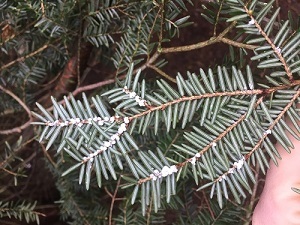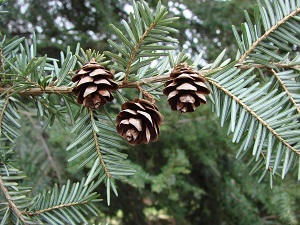Our neighbors to the East in Michigan have reported an outbreak of Hemlock Woolly Adelgid. These insects are considered invasive because they are not native to the state and can cause significant harm to Michigan’s estimated 170 million hemlock trees. As they feed, these tiny, soft-bodied insects consume a hemlock’s stored nutrients, slowly sucking the life from the tree.
 Infestations of hemlock woolly adelgid have been confirmed in Allegan, Benzie, Mason, Muskegon, Oceana, Ottawa and Washtenaw counties in Michigan.
Infestations of hemlock woolly adelgid have been confirmed in Allegan, Benzie, Mason, Muskegon, Oceana, Ottawa and Washtenaw counties in Michigan.
Winter is the best time to look for evidence of an infestation, according to Robert Miller, an invasive species prevention and response specialist.
“Cooler temperatures trigger feeding activity,” Miller said. “As hemlock woolly adelgid feeds, it secretes a white, waxy material that creates ovisacs. The presence of these small, round, white masses make it possible to identify infested trees.”
Throughout the winter, survey crews from the Michigan DNR and several cooperative invasive species management areas (CISMAs) will look for signs of hemlock woolly adelgid, conducting surveys within a 5-mile border along the Lake Michigan shoreline.
One of the CISMAs we work with in Forest County is Wild Rivers Invasive Species Coalition (WRISC). WRISC is responsible for Forest and Florence County in Wisconsin and Menominee, Dickinson and Iron counties in the UP.
Because hemlock trees can be protected from these insects with proper insecticide treatments, infested trees and any other hemlocks within the area will be mapped and tagged, then prioritized for summer treatment.
 Since adelgids feed and form ovisacs only on eastern hemlock trees, it is important to distinguish hemlocks from other conifers like pines or spruces. Look for:
Since adelgids feed and form ovisacs only on eastern hemlock trees, it is important to distinguish hemlocks from other conifers like pines or spruces. Look for:
- Cone- or egg-shaped trees up to 75 feet tall.
- Drooping or feathery branches.
- Flat needles growing individually from the sides of twigs.
- Needles that are dark green on top with two parallel, white stripes underneath.
- Papery cones about three-quarters of an inch long that hang downward from branches.
Late fall through early spring is the best time to check hemlock trees. Look on the undersides of branches for evidence of round, white ovisacs near the base of the needles.
Up close, ovisacs look like tiny cotton balls and may appear alone or in clusters. The short video “Hemlock woolly adelgid: invasive species in Michigan” provides helpful identification tips.
